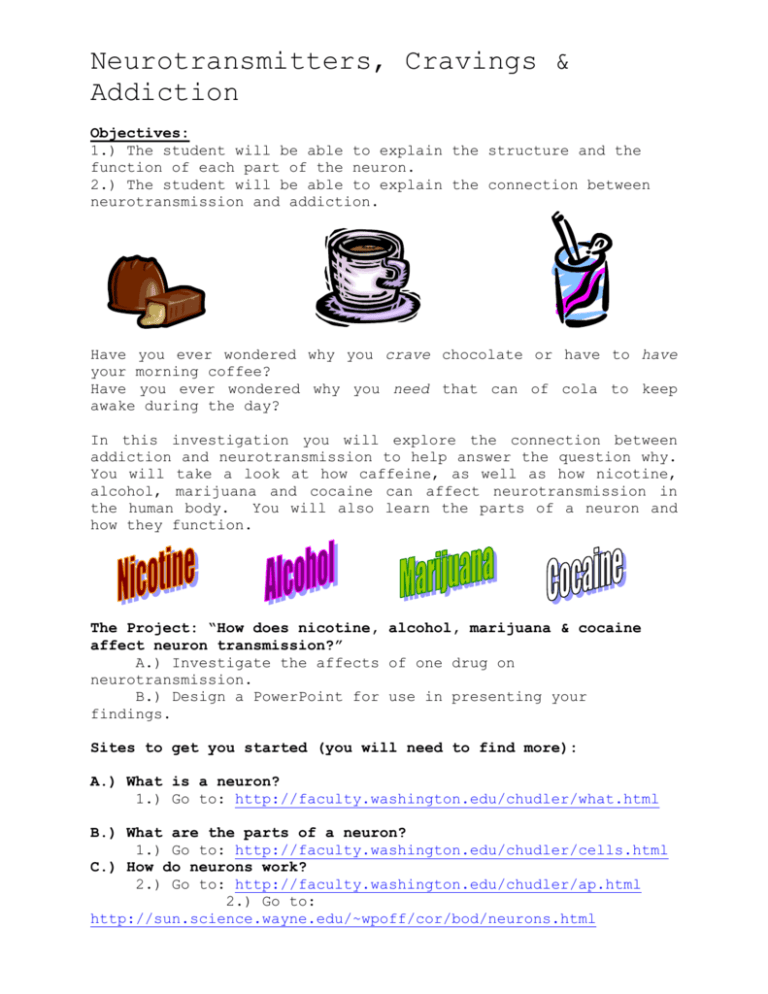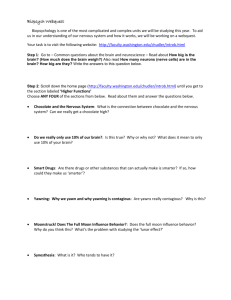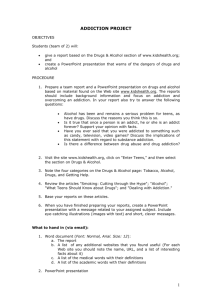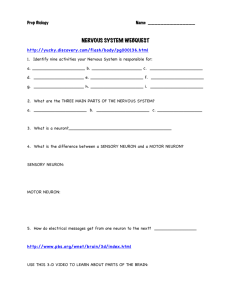Neurotransmitters, Cravings & Addiction
advertisement

Neurotransmitters, Cravings & Addiction Objectives: 1.) The student will be able to explain the structure and the function of each part of the neuron. 2.) The student will be able to explain the connection between neurotransmission and addiction. Have you ever wondered why you crave chocolate or have to have your morning coffee? Have you ever wondered why you need that can of cola to keep awake during the day? In this investigation you will explore the connection between addiction and neurotransmission to help answer the question why. You will take a look at how caffeine, as well as how nicotine, alcohol, marijuana and cocaine can affect neurotransmission in the human body. You will also learn the parts of a neuron and how they function. The Project: “How does nicotine, alcohol, marijuana & cocaine affect neuron transmission?” A.) Investigate the affects of one drug on neurotransmission. B.) Design a PowerPoint for use in presenting your findings. Sites to get you started (you will need to find more): A.) What is a neuron? 1.) Go to: http://faculty.washington.edu/chudler/what.html B.) What are the parts of a neuron? 1.) Go to: http://faculty.washington.edu/chudler/cells.html C.) How do neurons work? 2.) Go to: http://faculty.washington.edu/chudler/ap.html 2.) Go to: http://sun.science.wayne.edu/~wpoff/cor/bod/neurons.html 3.) Go to: http://faculty.washington.edu/chudler/synapse.html 4.) Go to: http://www.sfn.org/content/Publications/BrainBackgrounders/commu nication.htm 5.) Go to: http://science.education.nih.gov/supplements/nih2/addiction/acti vities/lesson2_neurotransmission.htm 6.) Go to: http://faculty.washington.edu/chudler/chnt1.html D.) What is the connection between neurons, the brain and the body? 1.) Go to: http://faculty.washington.edu/chudler/cells.html 2.) Go to: http://faculty.washington.edu/chudler/nsdivide.html Resource: Terms & Definitions for Neuroscience. Go to: http://www.sfn.org/content/Publications/BrainBackgrounders/gloss ary.htm The Project: How does nicotine, alcohol, marijuana and cocaine affect neuron transmission?” Directions: Investigate the affects of one drug on neurotransmission. 1.) What causes addiction? a.) Go to: http://www.sfn.org/content/Publications/BrainBriefings/addiction .html Read “Addiction's Path”, Brain Briefings, Society for Neuroscience, July 1997. b.) Go to: http://teens.drugabuse.gov/facts/facts_brain1.asp Read “Brain and Addiction”, National Institute on Drug Abuse 2.) Information on specific drugs. Drug Websites Caffe ine http://faculty.washington.edu/chudler/caff.html http://chemistry.about.com/od/moleculescompounds/a/caffei ne.htm?terms=what+is+caffiene%3F See #3 under … C.) How does caffeine affect neurotransmission? … as listed above. Nicot ine http://faculty.washington.edu/chudler/nic.html http://www.sfn.org/content/Publications/BrainBriefings/ni cotine.html http://parentingteens.about.com/cs/drugsofabuse/l/blnicot ine1.htm?terms=What+is+nicotine%3F Alcoh ol http://faculty.washington.edu/chudler/alco.html http://www.sfn.org/content/Publications/BrainBriefings/al coholism.htm http://www.sfn.org/content/Publications/BrainBriefings/br ain_on_alcohol.html Marij uana http://faculty.washington.edu/chudler/mari.html http://parentingteens.about.com/cs/marijuana/l/blmj1.htm http://teens.drugabuse.gov/facts/facts_mj1.asp Cocai ne http://faculty.washington.edu/chudler/coca.html http://www.sfn.org/content/Publications/BrainBriefings/gl utamate.html http://psychology.about.com/library/clinical/bladdiciton_ cocaine.htm Other Drugs http://www.drugabuse.gov/drugpages.html PowerPoint a.) Overall, the PowerPoint must be neat, colorful and have no spelling errors. b.) Must include 1 title slide, 1 works cited slide and at least 10 other slides and 7 pictures embedded somewhere in the slides (No slide should be JUST a picture). c.) Lettering must be readable from a short distance with block lettering. d.) PowerPoint must include these five facts/concepts in outline form or with the use of bullets: 1.) 2.) 3.) 4.) 5.) How the drug affects the human body. How the nervous system is affected by the drug. Which neurotransmitters are affected and how? Is the drug addictive? What are the withdrawal symptoms caused by the drug? e.) The five facts/concepts must be explained in your own words or cited with a source. Presentation a.) Must have a “hook” – Do you know? … to entice your listener’s attention. b.) Do your presentation with minimal amount of reading from your notes (i.e. Be prepared with note cards and practice your presentation). d.) Speak on each of the 5 areas indicated on the poster. Speak loud and clear - to be heard - with no mumbling! e.) Use your PowerPoint as your visual only!!. Rubric for Project: Oral Report & Poster WebQuest: “Neurotransmitters, Cravings and Addiction” Criteria Score (Max: 100 points) Novice Apprentice Proficient Distinguished (0 (1 point) (3 points) (5 points) points) All materials are ready to use for the oral presentation: (Max: 10 points) 1.) Note Cards ______ 2.) PowerPoint ______ Oral Presentation included: (Max: 10 points) 1.) A Hook – Do You Know? ________ 2.) Five Important Facts/ Concepts ________ Student spoke loud and clear. (Max: 10 points) Student spoke with a minimum amount of reading from his/her notes. (Max: 5 points) PowerPoint is neat, colorful, and readable. (5 points) Includes 7 pictures and 1 title, 1 works cited, and 10 additional slides, as required with no spelling errors(20 points). PowerPoint includes the 5 important facts/ concepts for the topic. Accurate information. (Max: 35 points) Student was on task with research and used time efficiently each day in computer lab (30 points) Evidence of Research with a minimum of 5 SPECIFIC sites: (Max: 5 points) Student Name________________________________ Period_____ Date___ Total Points Earned: ______________________ out of a possible 130 points. Grade for the Project: ____________________ %






